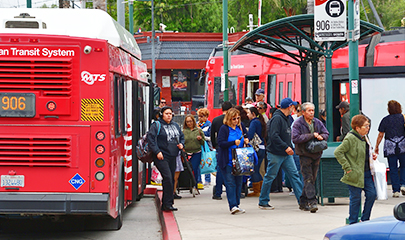At SANDAG, we prioritize the safety of transit riders and pedestrians across the region. It’s important for us to ensure riders and passersby know what to do when using and being around all modes of transit, especially trains, to feel safe and secure.
- To ensure the safety of yourself and others around trains, please remember these important tips for both pedestrians and drivers:
- Only cross train tracks at designated pedestrian or roadway crossings. These crossings are typically marked by a sign, lights, or a gate.
- Don’t cross the train tracks immediately after a train passes. In case a second train is approaching from either direction, wait until you can see clearly around the first train in both directions.
- Never cross a railroad crossing if lights are flashing or gates are lowered. Flashing lights and lowered gates indicate a train is approaching from either direction. It is only safe to cross when the lights have stopped flashing and the gates have lifted.
- Always stay alert around railroad tracks. Avoid distractions such as using your cell phone, headphones, and anything else that could prevent you from hearing an approaching train.
- Never try to beat a train to the crossing. By the time a locomotive engineer sees a person or vehicle on the tracks, it’s too late. It takes the average train traveling at 55 mph more than a mile to stop.
- If your vehicle stalls on the tracks, immediately evacuate yourself and everyone from the vehicle and stay far away from the tracks and the car. Call your local law enforcement agency for assistance.
- Expect a train on any track at any time. Most trains don’t travel on a regular schedule. Be cautious at any time of the day or night.
- Don’t become a statistic. Vehicles at train crossings and pedestrians walking on tracks account for 95 percent of all rail-related deaths. Almost all these deaths are preventable if you follow all safety tips and take precautions.
- More than 50 percent of people who die while walking on railroad tracks have alcohol or drugs in their system. Always make responsible decisions with your safety in mind.




















